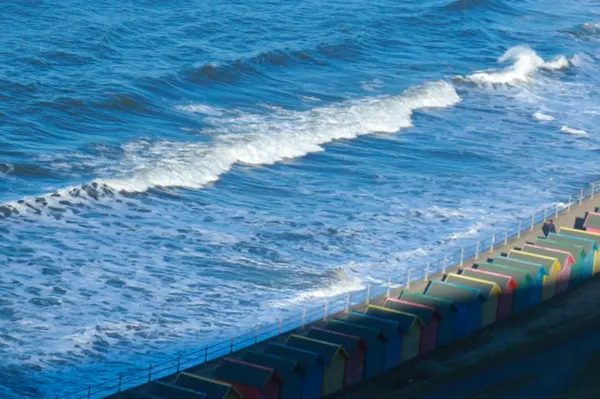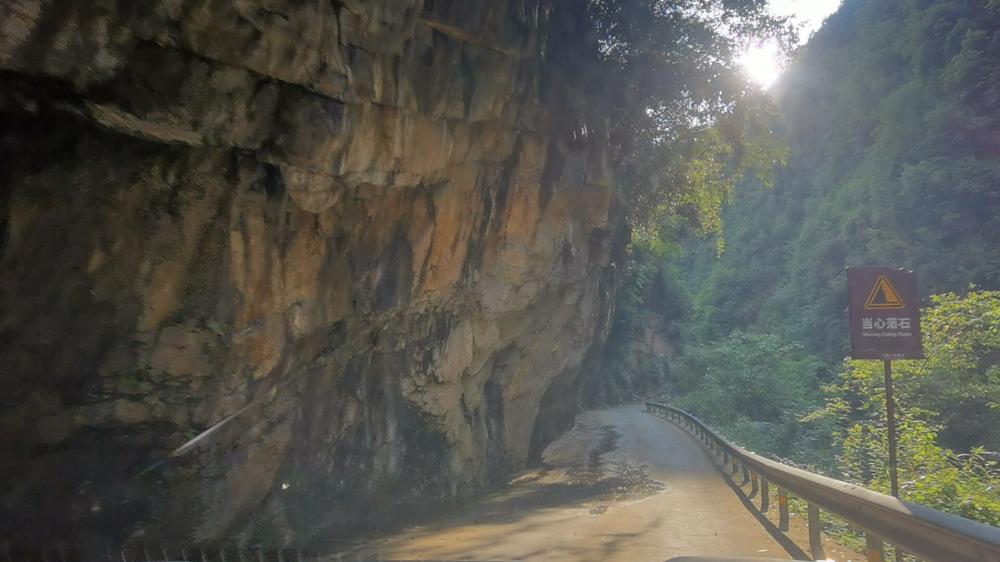Eyewitness documentary video: The long reconstruction after "Capricorn"
At 16:20 on September 6, "Makar" made landfall in Wenchang City, Hainan Province. This strongest autumn typhoon since the founding of New China caused severe damage to most areas of Hainan Province, western Guangdong Province, and southern Guangxi Province.
Gu Qiu lives in Longhua District, Haikou City. When she went out after the typhoon, she was shocked to find that "everything was out of place". Signs fell to the ground, traffic lights tilted left and right, trees that should have been straight up now lay horizontally on the ground, and the originally flat road surface was tilted as if it had experienced an earthquake. "Nothing was where it should be."
In this disaster, Gu Qiu's experience can be described as "lucky" - his family was safe, the house only had a small hole in the window, the power was briefly cut off for one night, but the water supply was not cut off.
But in the post-disaster photos we collected, more people, houses, and lives were "screaming" - this typhoon was extremely cruel.
The city needs to press the reset button and start from the restoration of each brick and each piece of wood. But what is more difficult is that people need to rebuild their hope for life.
The damaged Hainan province. Photo taken by Gu Qiu at the Hainan Provincial Fifth People's Hospital on September 11.
The local residents of Wenchang mostly make a living by raising Wenchang chickens and planting coconut and betel nut trees.
After "Capricorn" passed through Wenchang, more than 200 of the more than 300 areca nut trees in my family were completely blown down and could not be propped up, resulting in the loss of several years' income.
My family has been planting betel nut trees for more than ten years. We also experienced the Typhoon "Wilmason" 10 years ago. The power was also great, but the damage was not as serious as this time. Not only did the tree fall, the house cracked, the computer was soaked with water, and the car windows were all blown to pieces.
Early in the morning and evening of September 13, I went to Wanlv Garden twice to "visit" the banyan tree.
At around 8 o'clock in the morning, I saw its remains after the typhoon. The tree that had originally stood upright with a lush green crown was uprooted, half of it was dry and the other half remained, becoming a "yin and yang tree".
I stood aside and observed for more than half an hour and found that it was not easy to clean up such a huge monster. The workers first had to use an electric saw to cut the branches and transport them away. The remaining trunk needed to be straightened with a crane and the roots had to be re-rooted in the soil.
When I came back at 7pm, the banyan tree had a "new" look and stood tall on the lawn. I took a third photo and someone in my circle of friends commented, "This is a thorough haircut."
This is the tree of our school, located in Zhanjiang City, Guangdong Province. It grows by the lake of the school cafeteria. It is a landmark of our school and a must-take place for graduation photos every year.
I am a photography enthusiast and this is the place I took the most photos of at school, so I have a lot of feelings for it.
The first photo was taken in April this spring. You can feel its vigorous vitality. In the evening, people often come here to enjoy the cool air. My friends and I lie under the tree, enjoy the breeze, watch the sunset, and chat. It is peaceful and beautiful.
The second photo was taken on September 7, the day after Capricornus transited. When I woke up at noon, the first message I received on my phone was that the school's lover's tree had fallen down.
Now the school has rebuilt the half that was blown down. I believe that life has its own resilience. I hope that when I graduate next year, I can see the Lover's Tree on Lover's Hill regain its vitality.
On the 10th, when I was passing by Jinxiu Road, I saw a man standing on a tree. From a distance, he looked like he was walking on a balance beam. It was nearly two stories high, and I was worried that he would fall, but he looked so comfortable, with his legs lightly straddling the tree, holding a machete in his hand, swinging it again and again.
I saw him again when I passed by the next day. He was busy with cleaning work. I learned from the conversation that he was a property staff of Jinlong Community. The tree in the picture did not need them to clean it, but the tree fell from the neighboring community and crossed to their side. Unfortunately, the staff of the Yifu compound were too busy, so the tree was "hanging" on the wall, and they had to deal with it.
He told me, "It's only been a couple of days since the storm started to slow down." When the typhoon just passed, they had to work from 8 a.m. to 8 or 9 p.m. On the 12th, before 6 p.m., he finished his work for the day.
This is the most common sight on the roadside in Haikou after the typhoon: the streets are filled with chopped wood, the sound of electric saws is heard one after another, and the sawdust raises smoke. Because of the long working hours, the electric saws need to be refilled with oil from time to time.
I was very curious about where to transport all the wood in the city. When the chainsaw stopped, I approached them and asked. They were anxious and said, "Don't ask where to transport it first. Can you help us find a truck?"
On September 5, the day before "Capricorn" arrived, the weather was as usual. It was sunny and a bit hot. We received a notice to work from home a day in advance. After get off work, everyone went out to eat and drink as usual. At around 10 o'clock in the evening, I passed by this restaurant on Lantian Road in Meilan District. People were eating steaming hot pot in the house, and the owner was putting yellow tape on the windows outside the house to prepare for the upcoming typhoon.
I am from Guangxi and have been working and living in Hainan for more than ten years. After the typhoon, the water and electricity in the community were cut off. It was too hot and I couldn't stay at home, so I went downstairs to walk around the community and take photos.
The extent of the damage to the street was beyond my imagination. Many people gathered on both sides of the road, and everyone looked confused.
At this time, I happened to see a family coming from a distance, each of them holding a board. At that time, I felt that this family was very loving, there was no sadness on the children's faces, and the adults' eyes were also very determined.
I think, maybe having family is the most important thing. It doesn’t matter if the home is destroyed, as long as the family is there, the home is there.
My home is relatively close to Yundong, where there is a tourist attraction - Yundong Library, where many people go to check in. I like to go there to watch the sunset, which is very beautiful around 5 or 6 in the evening.
The day after the typhoon, I went for a walk in Yundong. The wind had become much weaker, just like the breeze at the beach. The weather was also much cooler, and everyone sat in groups of three or five and chatted at the beach.
September 11, Haikou City. This is the football field downstairs from my home.
Before the Typhoon "Capricorn" landed, dozens of people came to play football every day in this open court, including students after school and workers after work. They played football with great energy. When my mother and I walked by here, we often heard cheers from inside.
After the Typhoon "Capricorn", the grass here was damaged, the goal was deformed, and the roof of the badminton court next door was blown down. Before dinner, I happened to see a few middle school students playing football. Although the court was damaged, they still had a lot of fun.
I work in commercial photography, and it’s almost instinctive for me to “speak” with the lens.
The next morning after the typhoon, I went out with two cameras on my back. There was still a little rain in the air. I first went to the neighborhood next door to take pictures of the car that was crushed by the tower crane. It was a short distance, but it was almost over the mountains. There were broken glass shards on the ground, and branches and leaves blocked the road tightly. I had to find ways to make many detours. The shooting environment was very bad.
On the first day, I walked nearly 30,000 steps, focusing on the disaster site. Later, I wanted to change direction and focus my camera on ordinary people to see the plight of each household. So I posted a message on WeChat Moments, asking everyone which communities had large-scale balcony damage, and then ran to each one, found the right floor, knocked on the door, and asked if I could use their balcony to take pictures when I saw someone coming downstairs to get water. On the 7th, 8th, and 9th, I shot almost day and night.
After I posted the picture on WeChat Moments, someone said I had taken a picture of his friend, a shirtless man standing on a balcony, looking outside sadly. He asked me for the picture, saying he wanted to send it to his friend. I said he looked very sad. The other person sent me a picture of the interior of his friend's home, saying, "If your home was like this, would you not be sad?"
While filming, I watched him smoke many cigarettes in a row on the balcony.
On the streets of Haikou Guomao, residents whose homes had been without water carried buckets of clothes out to find water and wash clothes. When they came back the next day, the faucet knob was gone.
We were lucky enough to have no water outage. Relatives and friends came to our house with their families to take a shower and do laundry, and the door was almost filled with slippers.
After the typhoon passed through on Friday night, Haikou Friendship Sunshine City resumed business on Saturday morning, which was very fast. This mall is almost the most crowded in the city center, but this Saturday, there were obviously more people than usual.
To facilitate citizens, the mall has added collective charging points on each floor. Staff installed socket strips and put out tables and chairs, and people sit around to "recharge."
The power repair work in Wenchang was carried out day and night. The second picture was taken when I passed by Baimang Village in Wencheng Town. It was already after 9 o'clock in the evening. It was completely dark, and the workers were working hard with lights on. By September 12, the streets in Wencheng Town had basically restored electricity.
Each bottle in the picture contains a seedling. This is the tissue culture room of a research group in the Department of Crop Science, College of Tropical Agriculture and Forestry, Hainan University where I work.
The typhoon overturned the windows and blew over the culture bottles. These genetically modified cassava and tobacco seedlings have been cultivated for a long time, about half a year.
A senior student in the next laboratory was going to graduate with her cassava tissue culture seedlings, but the typhoon blew away her "graduation thesis" and she had to delay her graduation.
The morning after the typhoon, the community where I lived had no water, electricity, or signal. Because we didn't know when rescue would come, my husband and I took the universal tool and saw at home and spent more than an hour to finally open a road and drive out of the community.
When we were planning to take refuge in a city in the south, we were unfortunately stuck on the highway. While waiting for rescuers to clear the roadblock, I heard waves of animal calls from the pile of fallen trees on the side of the highway, anxious and rhythmic: "Moo... Moo..." Sheep were eating leaves from the trees.
Later, the highway was finally cleared and we rushed back to the car and left, but of course, we were unable to escape successfully in the end. With no electricity or internet, we were afraid of being stuck on the highway again, so we had to turn around and go home.
There are many stray cats in the community, and I usually feed them. When the typhoon came, I was worried about them.
On the evening of the 7th, after the typhoon, I went out to look for cats. I was really happy and relieved to see them running out to look for food and still alive. They were so small, but they were strong enough to withstand the storm.
I poured out the cat food and they ate it very quickly. They must be very hungry.
I planted a pot of bougainvillea on the windowsill on the south side of my house. It blooms in spring, and if it grows well, it will bloom red all year round.
At around 3 p.m. on the day the typhoon hit, when the wind speed was about level 10, I took a picture of it swaying in the strong wind.
After one night, there were originally at least seven or eight clusters of flowers, but only one lonely cluster remained, drooping there.
I stared at the blown leaves and shattered flowers, and an idiom popped into my mind: "honor in defeat".





